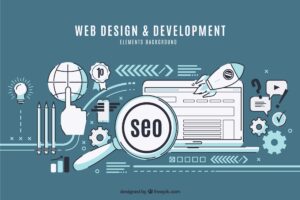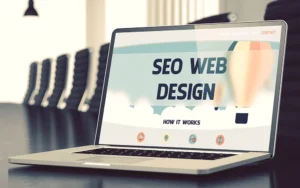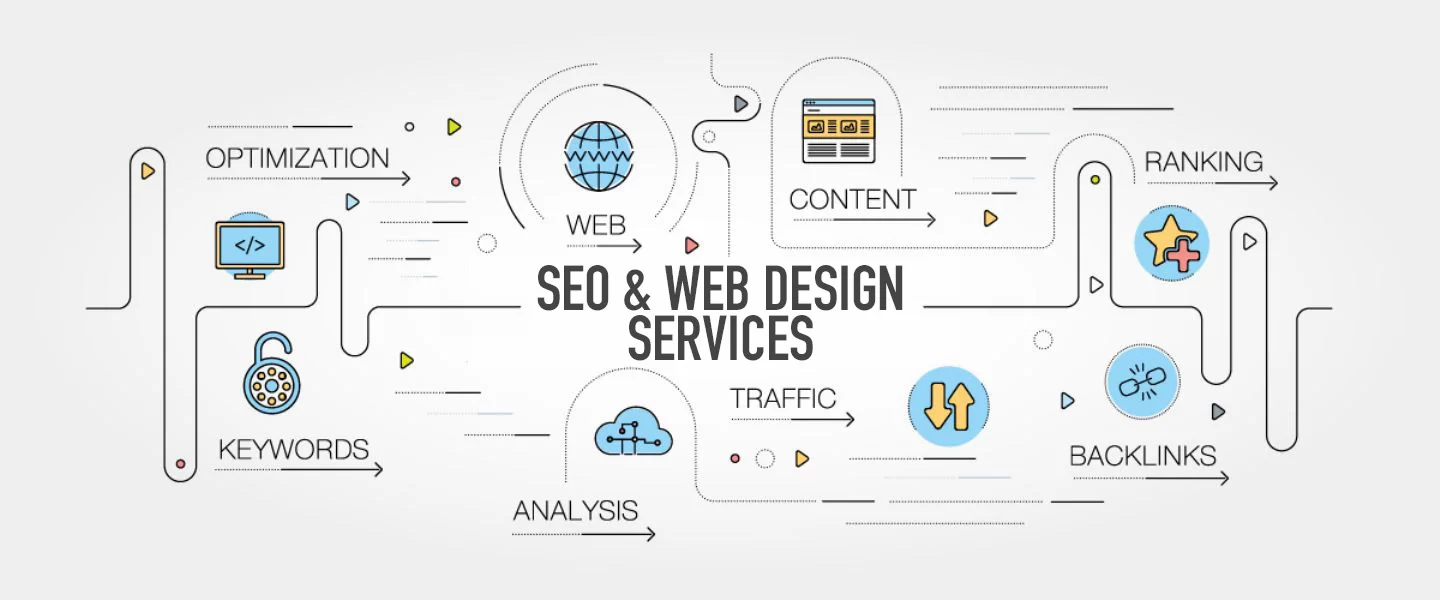How SEO and Web Design Work Together: A Complete Strategy for Success
In the ever-evolving world of digital marketing, two disciplines often treated separately — SEO (Search Engine Optimization) and web design — are actually deeply interconnected. Businesses that understand how to integrate SEO and web design from the ground up gain a significant edge over competitors. A visually beautiful website that no one can find serves little purpose, and a top-ranking site that frustrates users with poor design won’t convert.
This comprehensive guide will explore how SEO and web design work together, why their integration is critical, and what strategies ensure both search engines and users love your website.

Why SEO and Web Design Shouldn’t Be Separate
For too long, SEO and web design have been treated as distinct disciplines, often handled by different teams working independently. This siloed approach creates major problems: websites may look beautiful but rank poorly in search results, or they may rank well but fail to convert visitors due to frustrating user experience. The truth is, in today’s digital landscape, SEO and web design must be integrated from the start — because their goals are intertwined.
1. Shared Goal: Serve the User
At the heart of both SEO and web design is user satisfaction. Google’s mission is to deliver the best possible experience to its users, and it now uses sophisticated signals — like page speed, mobile usability, and engagement — to evaluate that experience.
SEO is about discoverability: getting users to the site.
Web design is about usability: keeping them there and guiding them to take action.
If either side fails, the whole strategy underperforms. A technically optimized page that’s ugly or hard to use won’t retain visitors. A gorgeous site that loads slowly or lacks proper metadata may never be found. These aren’t separate problems — they’re two halves of the same coin.
2. First Impressions Affect SEO Metrics
Your web design is the first impression users (and Google) get. In fact, studies show that users form an opinion about a site in just 0.05 seconds. If the layout is cluttered, the fonts are hard to read, or the design looks outdated, users may bounce — and bounce rate is a behavioral signal that search engines track.
SEO metrics affected by bad design include:
Bounce rate: Users leave without interacting.
Dwell time: Users stay longer on clean, intuitive websites.
Click-through rate (CTR): Better design of meta titles and descriptions, structured with branding in mind, gets more clicks from search results.
Pages per session: Thoughtful navigation and layout encourage deeper exploration.
Good design boosts SEO by positively influencing user behavior.
3. Mobile Design Is Now SEO Design
Mobile-first indexing means Google now evaluates your site based primarily on the mobile version. If your website isn’t designed with mobile usability in mind — thumb-friendly buttons, responsive layout, fast-loading images — it doesn’t just frustrate users, it hurts your search rankings.
Here, design choices (like fixed-width layouts or tiny navigation menus) can undo months of SEO work.
Integration means SEO teams must be part of the conversation during the mobile design phase. And designers must understand how mobile-friendly design directly influences crawlability, rankings, and visibility.
4. Technical SEO Relies on Design Foundations
A lot of technical SEO elements live in the backend, but many are shaped during the design and development stages:
Header tag hierarchy: SEO depends on correctly using H1, H2, and H3 tags to structure content. Designers must incorporate this structure in the wireframes and layouts.
URL structure: Clean URLs, based on site structure, need to be reflected in menu design.
Page templates: Blog layouts, product pages, and landing pages must balance design with schema, metadata, and crawlable content.
JavaScript rendering: Many visually dynamic designs use heavy JavaScript that search engines may struggle to crawl unless handled carefully.
The earlier SEO is involved in design conversations, the fewer performance issues will surface later — and the less rework is required post-launch.
5. Conversion Is the Final Goal
You don’t just want to rank. You don’t just want people to land on your website. You want them to do something — sign up, buy, download, call.
Design is the primary driver of conversions, but it can’t work in isolation. Your site can have the most beautiful CTA button and a perfectly optimized sales funnel, but if users never find it through search, it won’t matter. Likewise, SEO can drive traffic, but poor design or friction-filled UX can ruin the conversion process.
An aligned SEO and web design strategy ensures:
Traffic is targeted and qualified.
The user journey is clear and intuitive.
Calls-to-action are visible, persuasive, and well-placed.
Landing pages are optimized both for search intent and conversion.
6. Cost Efficiency and Scalability
Keeping SEO and design aligned from the beginning can save time and money long term. If design happens in isolation, SEO adjustments later can require reworking layouts, re-coding templates, or restructuring navigation — all of which adds unnecessary cost and delays.
A collaborative strategy from the start allows teams to:
Build flexible, scalable templates.
Reduce duplicate efforts and technical debt.
Streamline content and keyword integration into the design.
Launch faster, with fewer SEO setbacks post-launch.
7. A Unified Brand Experience
Brand trust and recognition influence both SEO and design success. When users see cohesive visuals, tone, and functionality, they’re more likely to engage, share, and return. That brand consistency should extend to:
Meta descriptions and headlines
Design elements and color schemes
Structured data and SERP features
Blog styling and content formatting
This alignment not only makes your site more memorable, but helps search engines better understand your niche and authority, improving your chances of ranking for relevant queries.
SEO and web design shouldn’t be separate — they should be synchronized. When they are, the result is a site that ranks high, loads fast, converts well, and delivers a seamless experience across devices.
By breaking down the silos between these two disciplines, you build not just a website, but a powerful online presence that grows, adapts, and drives value over time.
So, whether you’re launching a new website or redesigning an old one, SEO and web design should be part of a unified strategy — not separate checklists.

Now, let’s give you 10 reasons that why SEO and Web design works together:
1. Site Architecture: The Skeleton of SEO
A well-structured website allows both users and search engines to navigate effortlessly. Poor architecture can bury important pages, confuse crawlers, and frustrate visitors.
Best Practices for SEO-Friendly Site Structure:
Logical hierarchy: Pages should flow from general to specific, like Home > Services > SEO Consulting.
Internal linking: Use contextual links to guide users and spread link equity.
Flat structure: Minimize the number of clicks it takes to reach any page (ideally three or fewer).
Sitemap.xml and Robots.txt: Help search engines crawl efficiently.
This is where SEO starts to rely on design — designers must layout intuitive navigation menus and visual hierarchies that also serve SEO goals.
2. Mobile Design: The SEO Priority
More than 60% of all web traffic now comes from mobile devices. Google uses mobile-first indexing, meaning it ranks sites based on their mobile version.
How Design Impacts Mobile SEO:
Responsive design ensures your site adjusts to different screen sizes without breaking layout.
Touch-friendly elements like buttons and menus improve usability.
Minimalist mobile layouts load faster and are easier to navigate.
Designers must build with mobile in mind from the start, and SEOs should audit mobile performance regularly using tools like Google’s Mobile-Friendly Test or PageSpeed Insights.
3. Page Speed and Performance
Page speed is a direct ranking factor for Google and a critical UX factor. A delay of even one second can reduce conversions by 7%.
Ways Design Affects Speed:
Image optimization: Oversized, uncompressed images drastically slow down pages.
Code bloat: Poorly coded CSS and JavaScript can add unnecessary weight.
Third-party scripts: Chatbots, ads, and analytics can hinder performance if not loaded properly.
Tools like Lighthouse, GTmetrix, and WebPageTest help both designers and SEOs measure load times and identify bottlenecks.
4. Content Design and Readability
SEO depends on content. But design controls how that content is consumed. No matter how keyword-rich your blog post is, poor formatting can render it ineffective.
Key Elements of SEO-Driven Content Design:
Typography: Clear fonts and proper size make reading easier on all devices.
Headings (H1–H6): These help both users and search engines understand the content’s structure.
Whitespace and layout: Break content into digestible chunks. Long walls of text hurt readability and user retention.
Calls-to-action (CTAs): Strategically placed and designed CTAs increase conversions and reduce bounce.
Collaborate early between designers and content strategists to make sure visual formatting supports SEO content.
5. Image SEO and Visual Elements
Images are often overlooked in SEO, but they can drive organic traffic through image search and improve accessibility and page engagement.
Visual Design SEO Checklist:
Use descriptive file names: e.g., “seo-web-design-diagram.jpg” instead of “IMG0032.jpg”
Add ALT text: For both SEO and accessibility compliance.
Compress images: Use modern formats like WebP for faster load times.
Lazy-load non-critical images: Boosts initial page speed without sacrificing quality.
Visual storytelling can enhance a page’s SEO when integrated thoughtfully.
6. Navigation and UX Signals
Google tracks user behavior like time on page, click-through rates, and bounce rates. Poor navigation or confusing design can lead to premature exits, which in turn affects rankings.
How Navigation Impacts SEO:
Clear menu structures help users explore deeper into your site.
Sticky menus and breadcrumbs aid orientation and improve internal linking.
Avoid pop-up overload: Intrusive interstitials hurt both user experience and rankings (especially on mobile).
UX is not just about aesthetics — it’s about helping users accomplish tasks efficiently, which is exactly what Google rewards.
7. Core Web Vitals: Where SEO and Design Collide
In 2021, Google rolled out Core Web Vitals as a ranking signal. These metrics measure real-world user experience, including:
Largest Contentful Paint (LCP): How quickly the main content loads.
First Input Delay (FID): How responsive your site is to interaction.
Cumulative Layout Shift (CLS): Visual stability while loading.
Designers must collaborate with developers and SEOs to optimize for these metrics through clean design, efficient coding, and stable layout practices.
8. Branding and SEO Trust Signals
Good design builds trust — an intangible yet powerful ranking factor. When users trust your site, they engage longer, share more, and convert better.
Design elements that influence SEO trustworthiness:
Consistent branding across pages (colors, logos, voice)
Professional, modern layout instead of outdated templates
SSL certificates, trust badges, and clear contact info
UX flow that makes sense for the user journey
Search engines may not “see” brand design, but they measure its effects through user behavior.
9. Schema Markup and Design Opportunities
While schema is primarily a back-end SEO tool, it can influence how your design appears in search results (rich snippets, FAQs, star ratings, etc.).
Designers should plan how these rich snippets integrate visually with:
Product displays
Events
Reviews
Recipe or how-to pages
This is a great example of technical SEO working hand-in-hand with visual planning.
10. Collaboration: The Real Secret to Success
The most effective SEO and web design strategies are born from collaboration, not handoffs. When designers, developers, content creators, and SEOs sit at the same table from the start, they avoid costly fixes and build smarter systems.
Practical Steps to Encourage Collaboration:
Include SEO audits in design phases.
Use shared design systems or Figma files annotated for SEO.
Conduct joint QA testing for UX and SEO performance.
Educate teams on each other’s priorities.
Make SEO and design a shared language, not separate roles.

Final Thoughts: A Holistic Strategy Wins
SEO and web design are two sides of the same coin. They don’t just coexist — they elevate each other. A well-designed website that’s also search-optimized can:
Attract more traffic
Engage users longer
Convert more leads
Rank higher and faster
This blog is your base — a foundation for diving deeper into individual areas like mobile-first design, Core Web Vitals, content structure, image optimization, and more. Each of these deserves its own article (and internal link) to expand this strategy into a full content hub.
If you’re building or redesigning a website, now is the time to unite your SEO and design efforts. Think strategically. Think collaboratively. And build for users and search engines alike, and if you want, you can use our packages!
